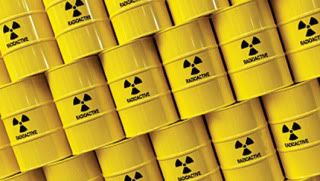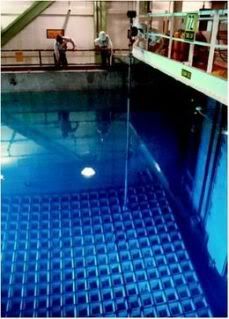 Nuclear waste is no laughing mattter. The highly radioactive waste from nuclear reactors is so daedly it must be contained, out of the environment and away from people, for hundreds of thousands of years. (No one has yet figured out how to do that, by the way.
Nuclear waste is no laughing mattter. The highly radioactive waste from nuclear reactors is so daedly it must be contained, out of the environment and away from people, for hundreds of thousands of years. (No one has yet figured out how to do that, by the way.
But it's hard not to chuckle when someone drags out the old illustration intended to minimize the problem. The latest to use the same old example is State Rep. Kevin Petersen, a Waupaca Republican:
A 12 ounce can of soda would hold one person's lifetime worth of spent nuclear fuel.
So, no problem, right? If each of us just carried around that soda can, or left it in the fridge, or under the bed, we could quite looking for a nuclear waste repository. Of course, we'd all come down with fatal diseases. But no point in mentioning that; it's a bummer.
Rep. Petersen may not remember, because he graduated from high school in 1983, but that was the same year voters of Wisconsin were asked, in an advisory referendum, whether they wanted our state to be the site of a nuclear waste repository. Eighty-nine per cent voted no, and the 11 per cent who wanted it have never come forward to explain why.
Petersen should have a special interest, because his home county was one of the areas being considered for a repository, as the federal government considered the Wolf River batholith, a granite formation in north central Wisconsin, as a repository site.
That didn't happen, and neither did any other solution. So after more than 50 years of producing nuclear waste, we have no safe, permanent way to dispose of it.
We can rule out the idea of each of us being responsible for our own 12 ounces.
This is especially relevant, by the way, because state lawmakers are considering a Clean Energy Jobs Act that would make it easier to build new reactors in the state, and eliminate the requirement that the waste problem be solved first.
One soda can per person doesn't sound like much, but let's put that into perspective. The Christian Science Monitor reports"
Today there are 60,000 metric tons of spent fuel awaiting permanent disposal, according to the Nuclear Energy Institute, an industry association, and the nation’s power plants produce 2,000 tons more each year. Even if work on Yucca Mountain had continued, it wouldn’t have solved the problem: By the early 2020s, when it would have been completed, the nation’s nuclear waste would have already exceeded the repository’s 70,000-ton capacity.
 Where is it? Mostly, it is stored next to existing nuclear reactors, like Point Beach and Kewaunee, either in pools of water (pictured)or in dry casks. Here's what the Dept. of Energy says about that:
Where is it? Mostly, it is stored next to existing nuclear reactors, like Point Beach and Kewaunee, either in pools of water (pictured)or in dry casks. Here's what the Dept. of Energy says about that:
Nuclear waste must be properly managed to minimize risk to the environment and to the health and safety of future generations.
Since the mid-1940s, spent nuclear fuel and high-level radioactive waste have accumulated throughout the country.
Currently, they are stored in temporary facilities at some 121 sites in 39 states. These storage sites are located in a mixture of urban, suburban, and rural environments — most are located near large bodies of water.
In the United States today, over 161 million people reside within 75 miles of temporarily stored nuclear waste.
Current storage methods shield any harmful radiation and are presently safe. However, modern aboveground storage structures are designed for temporary storage only, and will not withstand rain, wind, and other environmental factors for the tens of thousands of years during which the waste will be hazardous.
From a 2002 publication titled Radioactive Waste: Production, Storage Disposal comes this rosy picture
About 160,000 spent fuel assemblies, containing 45,000 tons of spent fuel from nuclear power plants, are currently in storage in the United States. Of these, about 156,500 assemblies are stored at nuclear power plants, and approximately 3,500 assemblies are stored at away-from-reactor storage facilities, such as the General Electric plant at Morris, Ill.The vast majority of the assemblies are stored in water pools, and less than 5% are stored in dry casks (photo at right)> About 7,800 used fuel assemblies are taken out of reactors each year and are stored until a disposal facility becomes available.
If all the 160,000 spent fuel assemblies currently in storage were assembled in one place, they would only cover a football field about 5 1/2 yards high.
Will Kevin Petersen suggest Camp Randall as a site, or will we keep carrying around our own soda cans of waste?
This is no joke. Building more reactors to create more waste when we can't even dispose of what we have is unconscionable. That's why people are working desperately to try to improve and stregthen the Clean Energy Jobs Act. If you want to help, there is much more information here.
